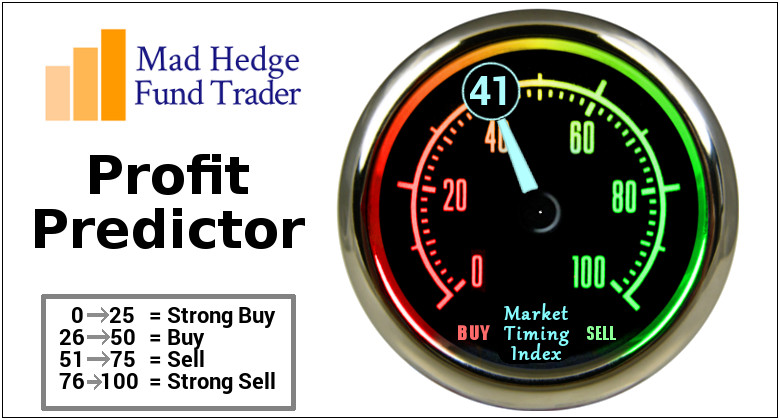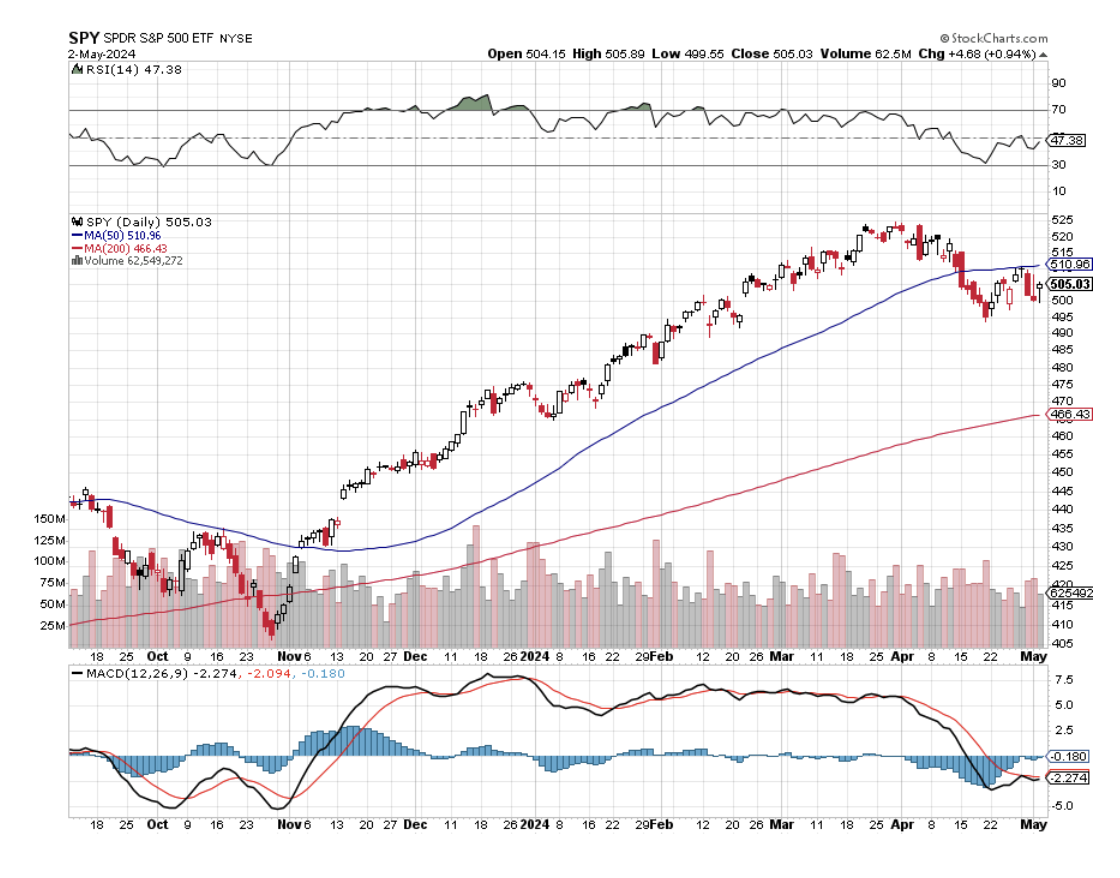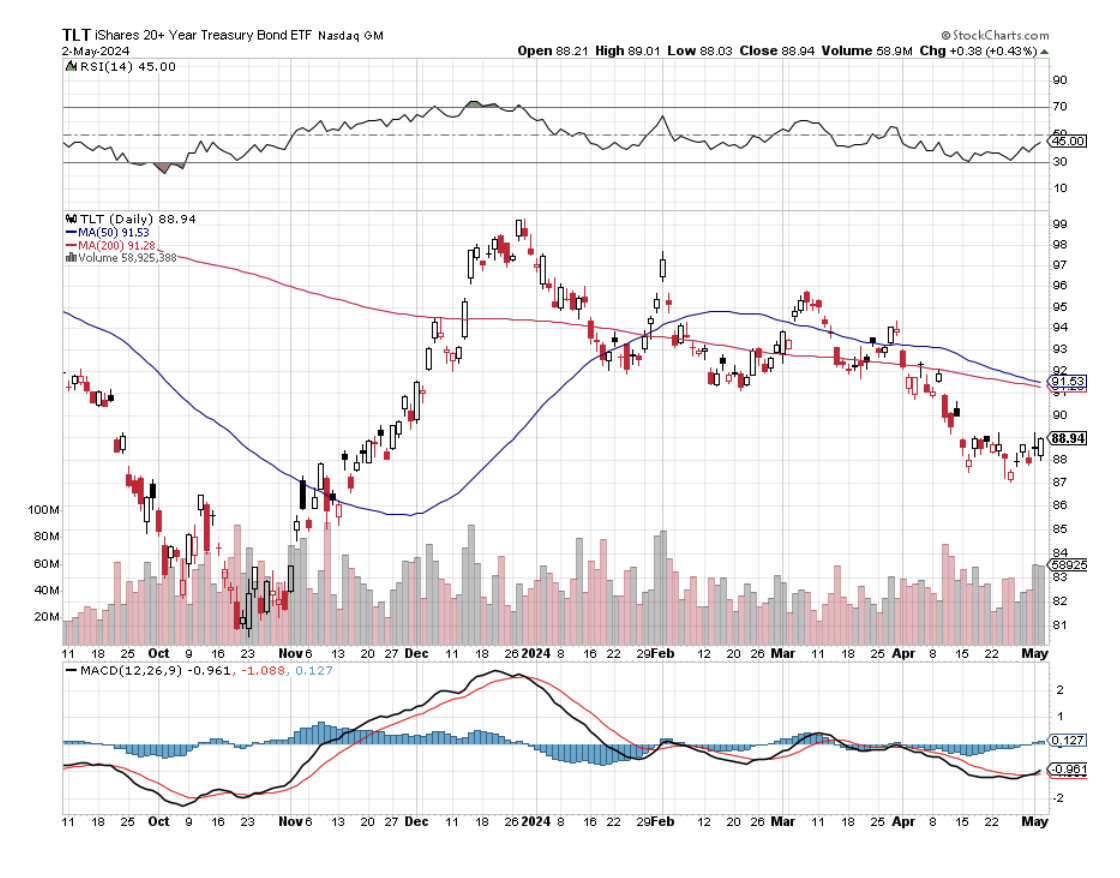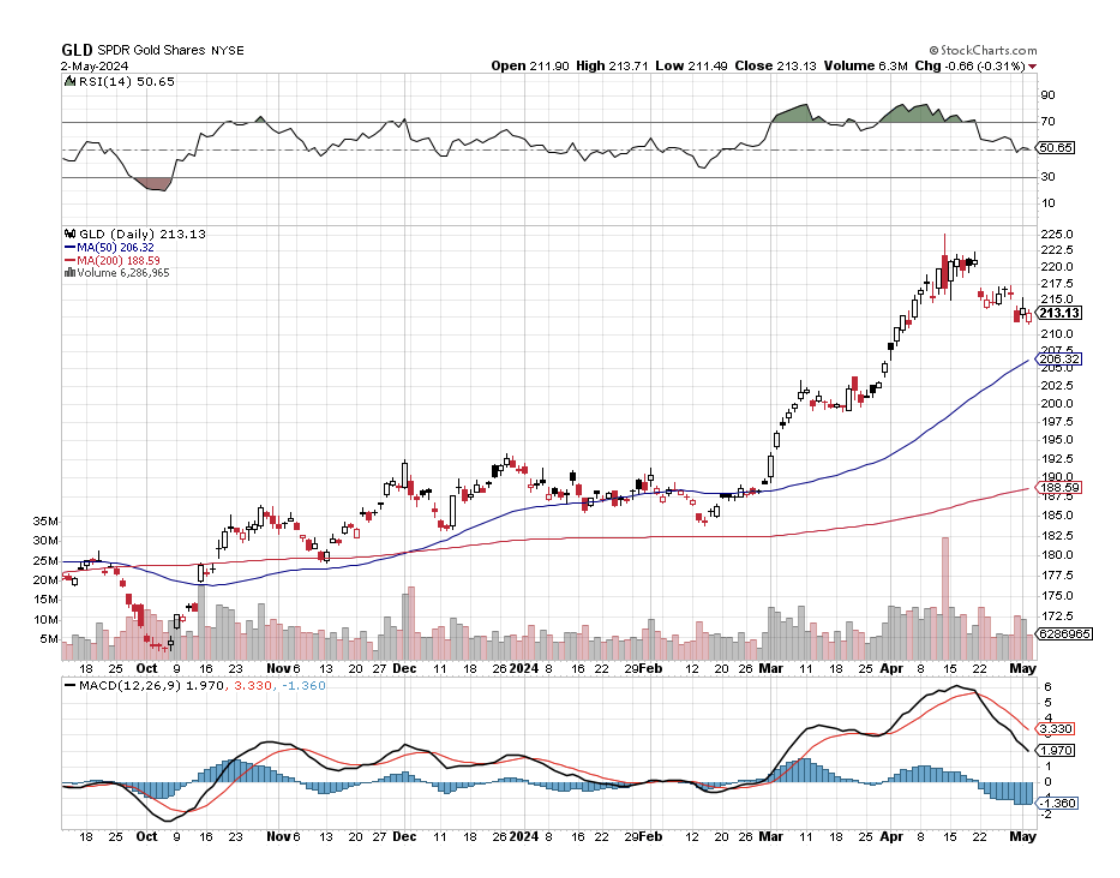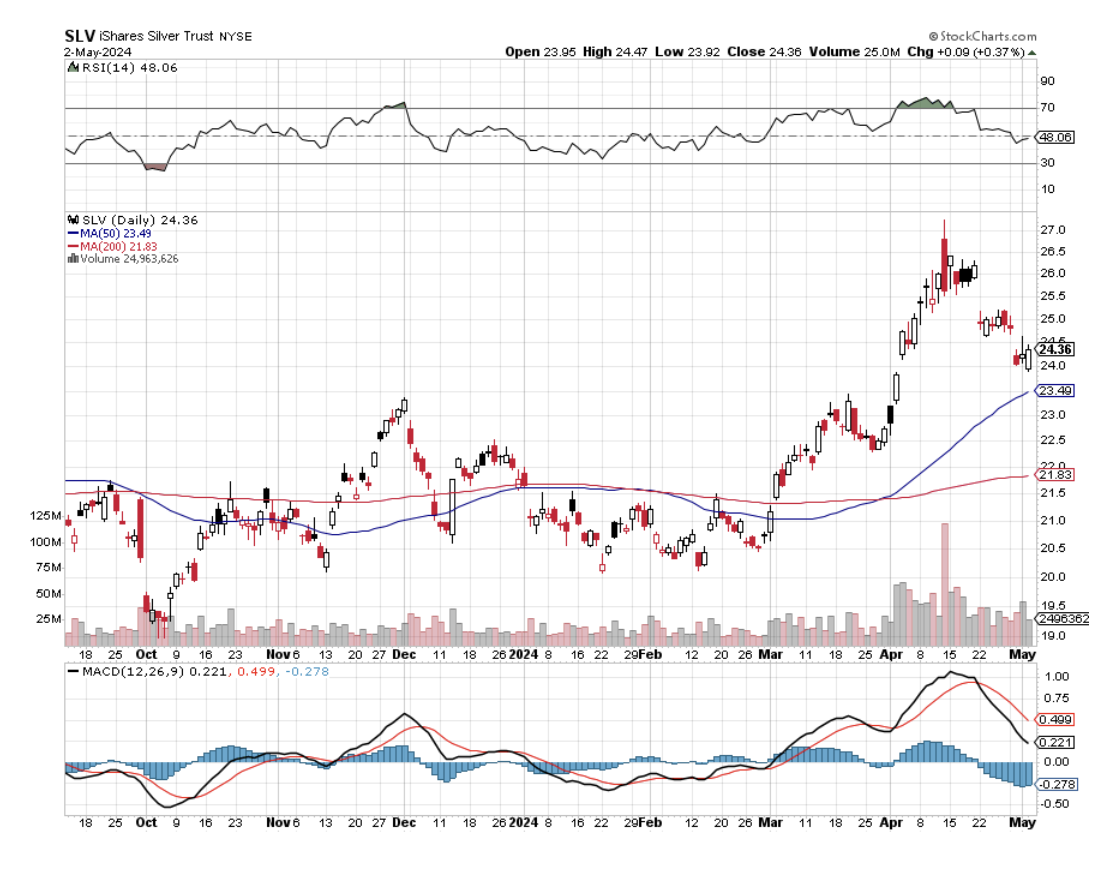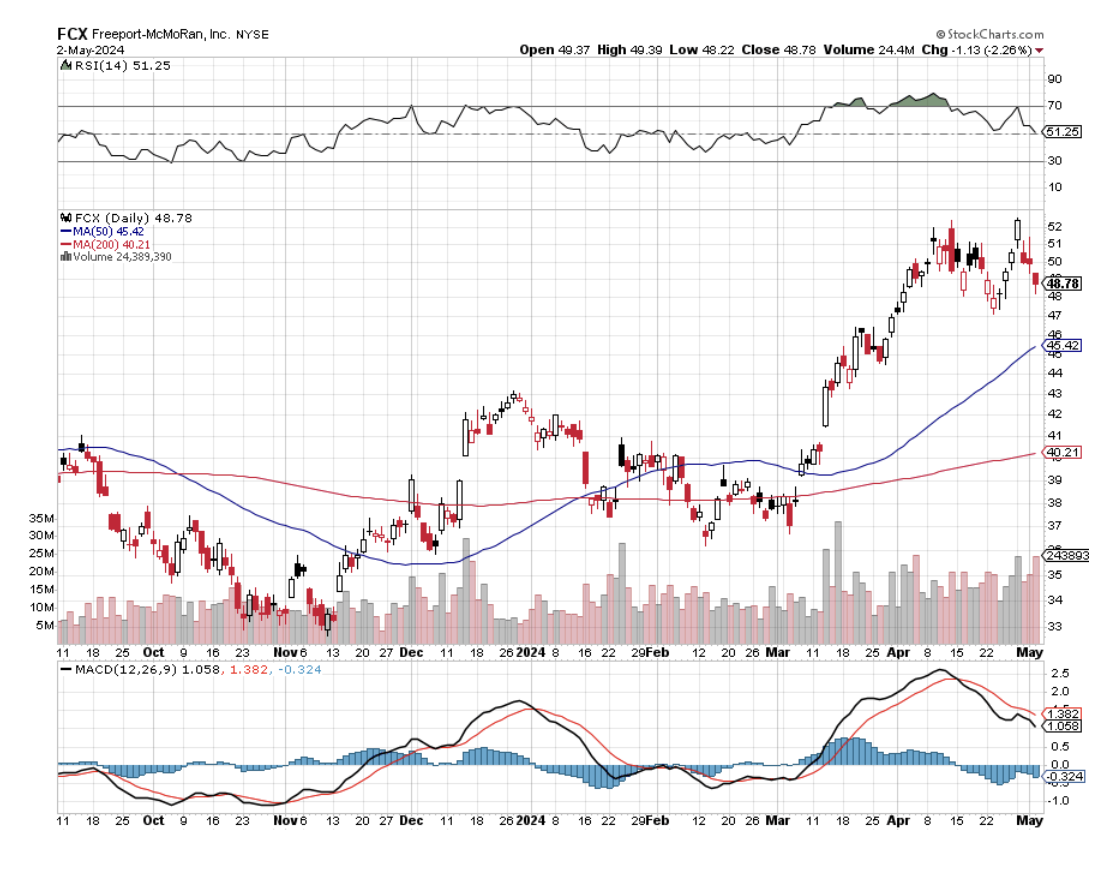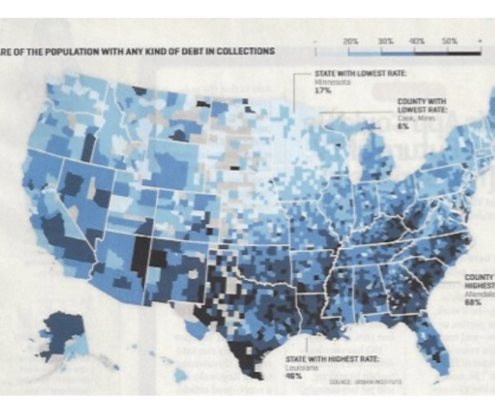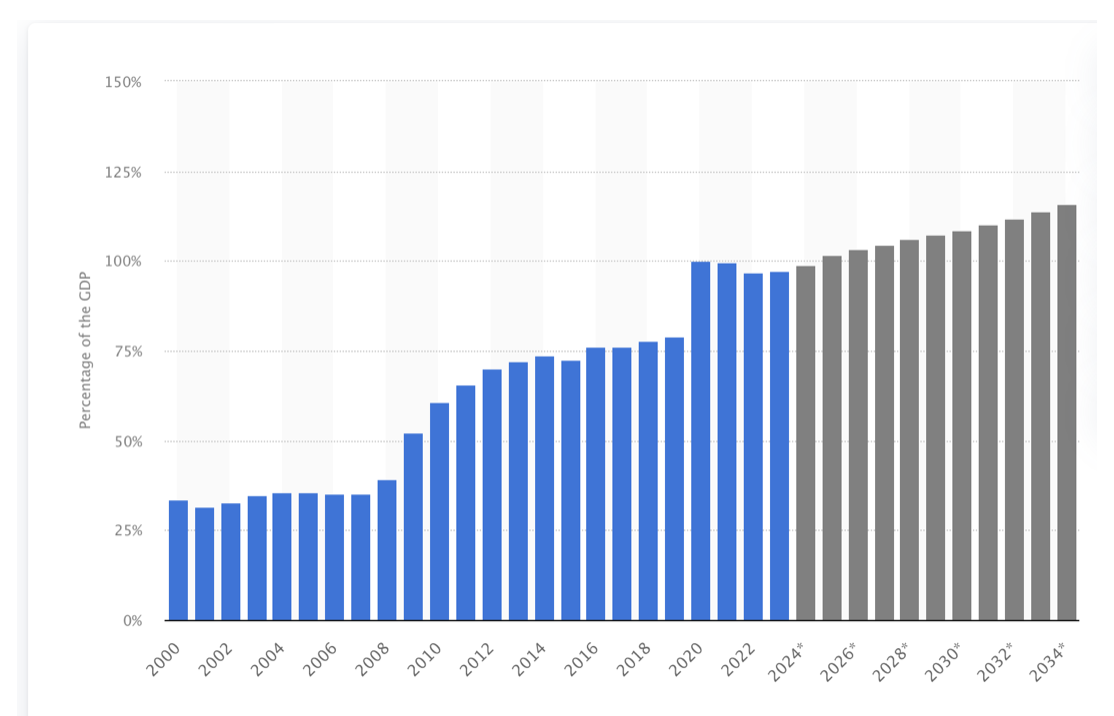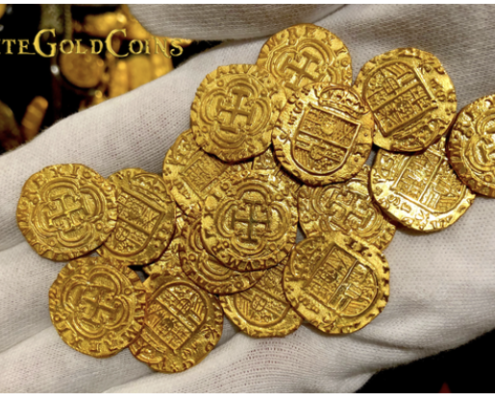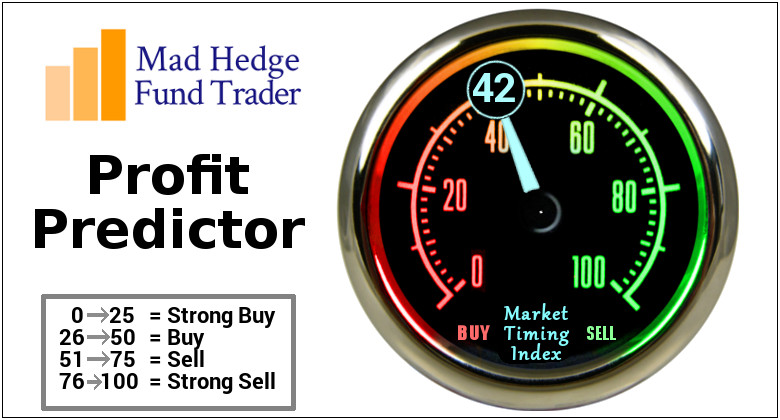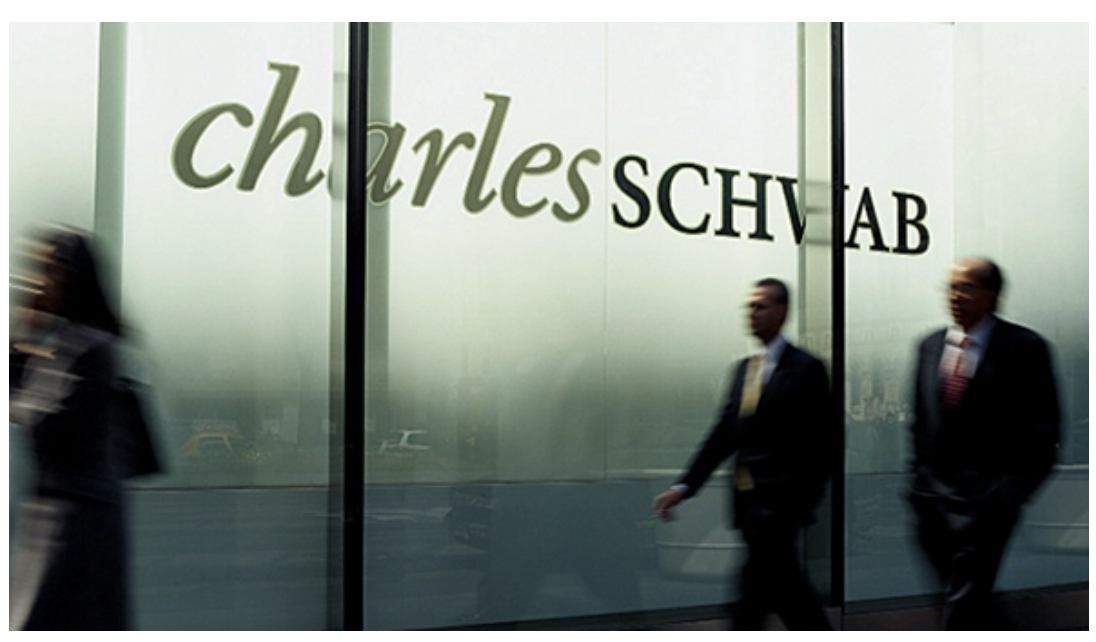
Global Market Comments
May 3, 2024
Fiat Lux
Featured Trade:
(MAY 1 BIWEEKLY STRATEGY WEBINAR Q&A),
(TSLA), (TLT), (GOLD), (GLD), (WPM), (NVDA), (OXY), (XOM)
Below please find subscribers’ Q&A for the May 1 Mad Hedge Fund Trader Global Strategy Webinar, broadcast from Silicon Valley.
Q: I see the Bank of Japan bought $35 billion in the foreign exchange on the market. What's going on?
A: First of all, they didn’t buy dollars, they sold dollars and bought yen. Well, It's really very easy. Interest rates are the primary driver of foreign exchange rates. Japan has had the lowest interest rates in the world for 40 years, and the US has had the highest for the last two years. So it’s an easy hedge fund trade—short the Yen, and use the proceeds there to buy US dollar assets—you pick up an automatic spread of 4.7%. You then multiply that 10 times, that becomes 47%, and goes into the trillions of dollars in size. And of course, every hedge fund in the world is doing this trade. So that is a massive amount of Yen selling. They sold some of of their massive dollar reserves in an attempt to head off the collapse of the Japanese yen which hit some Y160, a 40-year low. So that's what's going on there.
Q: What's your updated view on TLT, and what's your yearend view?
A: I think we kind of chop sideways as long as there's indecision on interest rates, and then maybe 3 points of downside max; and then after that, we start another twenty-point rally. So we're all waiting for the bottom of this move on the (TLT), and then we're going to go pedal to the metal, so that's an easy one.
Q: Would you stay away from DJT?
A: Absolutely. This is the most manipulated stock in the market and the largest short interest in the market. More people would short it if they could get the stock, which now costs 550% a year to borrow and has a SPAC set up. I never touch SPACs because 95% of those turn out to be failures. So go express your support for the former president in other ways would be my advice.
Q: My son-in-law works in AI and says Apple (APPL) will be a better player than Tesla (TSLA).
A: No it won't. First of all, Tesla is 15 years ahead of everybody on AI; they actually started a major AI effort in 2014, and they have the data of all the miles driven by 6 million cars all over the world, and nobody can replicate it; so that gives them a huge head start. Tesla also has Elon Musk running it, who would beat the pants on aggressiveness and competitiveness off Tim Cook all day long, so I would vote for Elon Musk on this one. But the next big AI surprise is probably going to come from Apple. That's going to happen in June when they have their developer's conference. I've already had several kids and relatives invited to attend that conference, so I’ll have a really good read on what's happening.
Q: Where do you see inflation for the rest of the year?
A: Tiny up to sideways and then down more—we may hit the 2% target by the end of the year. The key here is you have to let AI kick in and start generating profits instead of promises, as employees start being replaced with AI.
Q: Would you return to Havana?
A: I would. I had a great time, and now I have the knowledge of experience of having gone there. I was actually looking at Airbnb condos on the beach in Havana which you can get for $70 a month. You can't beat the prices in Cuba; they're like a 10th of anywhere in the world. You can buy a two-bedroom condo in Havana for $30,000. Compare that to New York—it would probably cost you $3 million, and would certainly cost you that much in San Francisco.
Q: What is a substantial dip?
A: I always get this question. It's different for each stock. It could be 5% for a boring one like Apple (AAPL), or 20% for a really wild one like Nvidia (NVDA). You can see both of them are acting like that right now, so it's different according to the volatility of the individual stock. There's no fixed answer.
Q: Are there expatriates living in Cuba?
A: There are, incredibly; some of them are working in the tourist industry, some in the computer industry. Would you consider it safe? Probably, yes, as long as you don't engage in politics. That would be a really big mistake. It's even dangerous for Cubans to have a political opinion. Best to just shut up and do what the government says; that's what totalitarian regimes are like. I've been in a lot of them, and by the way, that may be what it's like in the United States in another year, so we'll have to wait and see. I felt relatively safe in Cuba. I wasn't followed by the secret police, which I always used to be. Maybe I'm just not as valuable as I used to be!
Q: Do you have a ballpark timeline for Freeport-McMoRan (FCX) to reach under?
A: Time is always difficult to call because there are just so many variables and black swans out there, but I easily could see a spike in (FCX) going up to $100 sometime in 2025 when the global economy starts to recover; and if you're doing LEAPs on any depth here, I would go out to end of 2025 just to be safe. If Chinese ever starts new home contraction again that becomes a chip shot.
Q: The Feds are moving marijuana stocks from a schedule 3 to a schedule 1. Are there any plays here?
A: Well, I've never been a big fan of pot stocks. The barriers to entry are very low from anybody to come in as a competitor. At the end of the day, it's a brand play, much like Coca-Cola (KO), and they still have huge competition from the black market, because the black market doesn't have to pay the 30-40% in sales taxes. And it's a fairly poorly managed business—guess why? Everybody is stoned all the time. So I'm going pass on marijuana, there's too many better fish to fry. Leave it to the potheads.
Q: Why has Nvidia (NVDA) gone flat?
A: Trees don't grow to the sky. Nvidia was up 140% in 6 months, and you have to give time for the earnings to catch up with the stock. The earnings are growing at 40% a year, so they'll catch up pretty quickly. I'm thinking we could have a shot at $1,400 in Nvidia by the end of the year.
Q: McDonald's (MCD) just had a big sell-off on weak earnings, is it a buy-down here?
A: No. McDonald's has the highest exposure to sub $50,000/year earners of any of the fast food companies; they're the ones most affected by McDonald's high prices. Their margins are being crushed, and automation can't happen fast enough. And then there's the Ozempic effect: weight loss drugs are killing appetites, and eventually we'll have a hundred million people on weight loss drugs. And my bet is a lot of those are McDonald's customers, so avoid Mickey D.
Q: What about the silver trade?
A: Silver is actually starting to outperform gold on the upside as it has historically done, so you might go along with a pair of trades owning both gold (GLD) and silver (SLV). Gold just sold off at 5% and silver sold off at 10%, so maybe the old volatility of silver is returning. I'd look to buy Wheaton Precious Metals (WPM) LEAPs down here.
Q: Do you think Starbucks (SBUX) is in the same boat as McDonald's (MCD)?
A: After the similar earnings sell off, I'd say yes. Starbucks doesn't do well in recessions or economic slowdowns. It’s an easy product to economize on. And they don't do well with the sub $50,000/year crowd either. Plus, I think Starbucks in particular is being weighed down by weak China sales.
Q: What's your outlook on energy?
A: Buy the dip. We're all looking for economic recoveries worldwide next year—oil does really well in that situation. We just have to work off the current overbought situation that was given to us by the Gaza War.
Q: Why are the miners not keeping up with gold and silver?
A: The answer is inflation. Inflation in the mining industry is double or triple what it is in a regular economy because you have so many companies chasing so few production resources. For example, those giant tires that go on these huge Caterpillar trucks—those are $200,000 a tire, and there's a two-year waiting list to get one. So as more people try to mine, the cost of mining goes up. That feeds into the earnings of the mining companies. Also, miners are subject to the whims of the stock market, which the metals aren't. So that's why I've been recommending the metals first and then miners second.
Q: With the new Amazon (AMZN) earnings, will they someday pay out a dividend?
A: They just delivered their first substantial profit in the company's history that I'm sure is by design, and if they're willing to increase benefits to shareholders, can dividends and stock buybacks be far behind? If that happens, you can expect Amazon stock to double from here. So absolutely, yes.
Q: Is housing about to crash because of high-interest rates?
A: Absolutely not. It's about to take off like a rocket as interest rates fall. You'll never get a crash in housing as long as we have a shortage of 10 million houses. Housing shortages don't get crashes. We had a housing oversupply in 2007 and 2008, and that's what caused that housing crash; but half of the home builders went under then and they never came back, creating the current shortage. In the meantime, people are using 5/1 ARM loans to get lower interest rates and praying that rates fall by the time the first adjustment comes along. Then they'll move into much lower 30-year rate mortgages right around the 5% level. That is the plan of a lot of home buyers these days.
Q: How are technology companies going to cope with the margin squeeze?
A: They will fire people. They have fired 300,000 people in the Bay Area in the last 2 years, and as a result, the stocks have skyrocketed. The prime example is META (META), which fired 20% of the staff and saw the stock double. Once that happened, everybody else jumped on the bandwagon and started laying off people like crazy. It was actually Elon Musk that started the whole cost-cutting trend in Silicon Valley, so you have to thank him for that.
To watch a replay of this webinar with all the charts, bells, whistles, and classic rock music, just log in to www.madhedgefundtrader.com, go to MY ACCOUNT, select your subscription (GLOBAL TRADING DISPATCH, TECHNOLOGY LETTER, or Jacquie's Post), then click on WEBINARS, and all the webinars from the last 12 years are there in all their glory
Good Luck and Stay Healthy,
John Thomas
CEO & Publisher
The Diary of a Mad Hedge Fund Trader
'The dollar has become a carry trade rag these days. As Rodney Dangerfield would have said, it gets no respect whatsoever,' said Boris Schlossberg of GFT Forex.
Global Market Comments
May 2, 2024
Fiat Lux
Featured Trade:
(THE UNITED STATES OF DEBT)
(TLT)
The “Exploding National Debt” has been overhanging the markets for as long as I can remember and has had absolutely zero effect. Those who cashed out of markets, sold their homes, and hid everything under their mattress have missed the investment opportunity of the Millennium since 2009.
Why is that?
With ten-year Treasury bond yields grinding up from 0.32% to 5.10% during this period, there is some cause for concern.
The fact is that America has taken advantage of its reserve currency status to become an industrial-strength borrower. The US National Debt now stands at an incredible $34.5 trillion, up from $10.8 trillion in 2008 when Mad Hedge Fund Trader was first published. The United States is now on the hook for more money than any other country in history. That works out to an eye-popping $102,985 per US citizen.
We have, in fact, become the United States of Debt. The debt now accounts for 136% of America’s $25.44 trillion GDP, far more than was seen during the 106% WWII peak. And they were worried then.
What’s worse? Over the next decade, the national debt is expected to soar to $43 trillion, assuming that we don’t get into any new wars where it will become much more.
Current US Secretary of the Treasury Janet Yellen recently confided to me that, “It’s the kind of thing that should keep you awake at night.”
It gets worse.
According to the Federal Reserve Bank of New York, total personal debt topped $17.50 trillion by the end of 2023. An overwhelming share of personal consumption is now funded by credit card borrowing.
Some 33% of Americans now have debts in some form a collection, and that figure reaches an astonishing 50% in many southern states (see map below). Call it the Confederacy of Debt.
Corporations have also been visiting the money trough with increasing frequency. The rating agency Standard & Poor’s has said there could be hard times ahead for corporate America, which, according to the Federal Reserve, is carrying a $13.7 trillion debt load. Company debt has jumped 18.3% since 2020 as companies took advantage of the Fed's slashing interest rates in the early days of the Covid-19 pandemic.
The debt-to-capital ratio of the top 1,000 companies has ballooned from 35% to more than 54% and is now the highest in 20 years.
Automobile debt now tops $1.6 trillion and with lax standards has become the new subprime market, accounting for 9.2% of all consumer debt.
And remember that other 800-pound gorilla in the room? Student debt now exceeds $1.6 trillion and is rising, as is the default rate. Provisions in the last tax bill eliminate the deductibility of the interest on student debt, making lives increasingly miserable for young borrowers.
Of course, you can blame the low-interest rates that have prevailed for much of the past decade. Who doesn’t want to borrow when the inflation-adjusted long-term cost of money is FREE?
That explains why Apple (AAPL), with $170 billion in cash reserves held overseas, borrowed via ultra-low coupon 30-year bond issues, even though it didn’t need the money. Many other major corporations have done the same.
And while everything looks fine on paper now, what happens if interest rates rise from here?
The Feds will be in dire straight very quickly. Raise short-term rates to the 6% seen at the peak of the last cycle, and the nation’s debt service rockets from 4% seen at the last low to a bone-crushing 10%. That’s when the sushi really hits the fan.
You can expect the same kind of vicious math to strike across the entire spectrum of heavily leveraged borrowers going forward, including you and me.
Rising rates are increasingly shutting first-time buying Millennials out of the housing market, as extortionate 7.25% interest rates prove a formidable barrier.
We are also witnessing the withdrawal of the Chinese as major Treasury bond buyers, who along with other sovereign buyers historically took as much as 50% of every issue.
Don’t expect them back until the dollar starts to appreciate again until relations between the two countries improve.
Rising supply against fewer buyers sounds like a recipe for much higher interest rates to me.
With these kind of exponential numbers staring us in the face, why hasn’t financial Armageddon happened already?
I’ll explain.
While at first look American debt is rising, it has in fact been falling in terms of purchasing power. I’ll use 2022 as an example where the trends are most clear. The National Debt rose by $1.5 trillion. But the inflation rate that year was 9.1%. That means the outstanding debt shrank by 9.1%, from then $31 trillion to only $28.2 trillion. Compound this over 30 years, the maturity of the longest debt issued by the US Treasury and how much is the existing national debt?
Zero.
That’s what happened to the Revolutionary War debt, the Civil War Dent, and the debts from WWI and II. It all goes to debt Heaven.
Of course, we’ll never get the national debt down to zero because the government keeps spending. Neither American poetical party wants to own a recession for fear of losing elections. The last one who suffered that fate was George W. Bush, who opened the door for Barrack Obama with the Great Financial Crisis. So politicians have learned to spend whatever they must to avoid a similar fate.
If you have a better economic theory as to why we can’t keep borrowing I’m all ears. But you be going against the long-term trend of history.
You may think that I’ve been smoking California's biggest export to come up with such a hair-brained theory. But there is one person who heartily agrees with me and that is Mr. Market. If we really had a debt crisis stocks and the US dollar would NOT be at all-time highs, the economy would NOT be growing at a robust 3.4%, an inflation this year would NOT be down to only 3.2% against a long-term average of only 3.0%. Nor would foreign investors and central banks still be buying half our new bond issues with both hands, as they are.
No Armageddon here, no debt crisis, nothing t see here.
That’s what Mr. Market thinks anyway and he is always right.
“Individuals should be buying a little bit of gold every month forever,” said Marc Faber, publisher of the Gloom, Boom, and Doom Report.
Global Market Comments
May 1, 2024
Fiat Lux
Featured Trade:
(SEVEN REASONS TO BUY CHARLES SCHWAB),
(SCHW), (TLT), (GS), (MS), (C), (BAC),
(TESTIMONIAL),
(TAKING A BITE OUT OF STEALTH INFLATION)
Looking for a financial to add to your tech-heavy portfolio?
I think the nimble investor can pick up shares of online broker Charles Schwab (SCHW) and gain an outsized return.
That’s assuming that the current correction in the stock market remains in single digits, and doesn’t explode into a full-blown bear market.
There are many things that can go right with (SCHW).
Of the major online brokers, Charles Schwab pays the highest tax rate. With the least amount of international business, it is unable to hide billions of dollars tax-free offshore, as do (GS), (MS), (BAC), and (C).
It therefore pays the highest tax rate of the major financials and will be the most to benefit from any tax cut, if and when that ever happens.
Big funds have been soaking up the stock all year.
That leads to the second play. With the smallest amount of international earnings, the company will suffer the least from a coming weak US dollar.
With 90-day US Treasury bill ticking at 5.39% this morning, the greenback will almost certainly remain strong for a few more months. Once the cuts start, look out below.
Since financials are the one sector most sensitive to interest rates, (SCHW) should do well when rates fall.
At a 4.70% ten-year yield, we are closer to the bottom in all fixed-income yields than the 2020 top at 0.32%.
Personally, I don’t think the ten-year will go any lower than 5.10% in this cycle.
Here is the fourth reason to pick up some (SCHW).
When my New American Golden Age resumes, stock markets will rise threefold and volumes will explode.
The retail investor will make a long-awaited return to investing in equities.
Ever wonder why your online brokers keep disappearing?
Why TradeMonster get taken over by Option House, which then was swallowed by E-Trade?
It’s the major players making bets that financials will become the top-performing sector of the next decade. Always follow the big money.
This makes Charles Schwab a takeover target.
And if Schwab doesn’t get bought out, it will benefit from reason number six, a huge concentration of the industry that will finally allow commissions to RISE instead of fall, as they have over the last four decades.
Reduced competition always leads to higher profits. If you’re not convinced look no further than the airline business.
Charles Schwab originally sprang from a well-written newsletter from the 1960s and is now both a bank and brokerage firm, based in San Francisco, California.
It was founded in 1971 by Charles R. Schwab and was one of the earliest discount brokerage houses. It is now one of the largest brokerage firms in the United States.
The company provides services for individuals and institutions that are investing online.
(SCHW) offers an electronic trading platform for the trade of common stocks, preferred stocks, futures contracts, exchange-traded funds, options, mutual funds, and fixed-income investments.
It also provides margin lending and cash management services. The company also provides services through registered investment advisers.
It is not cheap, with a price-earnings multiple of 31, but it does offer a dividend of 1.33%.
This is a market that is all about expensive stocks getting more expensive, which cheap stocks (retail) get cheaper.
(SCHW) total market capitalization stood at $110 billion at the end of trading yesterday.
Of course, there’s the seventh reason to buy the shares of Charles Schwab.
I have the box next to the one owned by (SCHW) founder and CEO Charles Schwab himself at the San Francesco Opera House.
At the intermission for the season opener for Puccini’s Turondot, I asked him what he thought about the price of his shares here.
All he would say was “I’m not selling”, and gave me a wink.
The last time I bet on a wink like that, I got a double in the shares.
That’s good enough for me.
Dear John,
I loved your trades this year!
10% plus in a day? I’ll take as many of those as you can dream up.
And pulling this off in this boring market is incredible.
After reading BS and extreme negativity in my other newsletters all day long, you are a breath of fresh air.
Keep them coming.
David
Austin, Texas
When I visited the local fire station in the spring, I was snared by some uniformed pre-teens, backed by beaming mothers behind a card table selling Girl Scout cookies.
I was a pushover. I walked away with a bag of Thin Mints, Lemon Chalet Creams, Do-Si-Dos, and Tagalongs.
I have to confess a lifetime addiction to Girl Scout cookies. I am also sympathetic because while growing up, I had five sisters who were Girls Scouts.
During the early eighties, one of the managing directors at Morgan Stanley's equity trading desk had a daughter in this ubiquitous youth organization.
One day, she pitched to all 200 traders on the floor, going from desk to desk with sheets of paper taking orders.
I used to buy two of everything she offered, as some of my clients preferred a few boxes of these delectable treats over lunch at the Four Seasons.
Others ordered hundreds. I later heard that the girl was the top-performing scout in the greater New York area two years running. I remember well the truck backing up to the building’s loading dock to deliver the plunder.
However, this year, when I got home and opened the boxes, I was shocked.
While the price was the same, the number of cookies had shrunk considerably. I knew it was not my waistline the scouts were concerned about. I was seeing the dastardly hand of “stealth inflation” at work.
In this highly deflationary environment, companies are loathe to raise prices.
Any attempt to pass these costs on to consumers is punished severely. So companies cut costs, quantity, and quality, instead, by shrinking the size.
I think you are seeing stealth inflation breaking out everywhere.
It is not just in food. Many products seem to be undergoing a miniaturization process while prices remain unchanged. It also extends to services, where a dollar buys you less and less. Even the president was complaining about the shrunken size of Snickers.
This is how the consumer prices index is staying in very low single digits, despite anecdotal evidence everywhere to the contrary.

